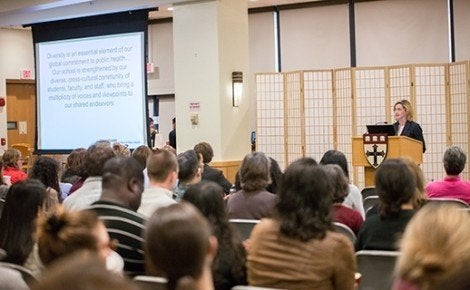November 3, 2015 — Creating a more welcoming climate for all. Recruiting and retaining a more diverse group of students, staff, research appointees, and faculty. Fostering stronger connections with the surrounding Mission Hill community.
These were some of the issues addressed at a Town Hall on Diversity and Inclusion at Harvard T.H. Chan School of Public Health on October 28, 2015. The event, held in Kresge Cafeteria, was open to the Harvard Chan community.
Acting Dean David Hunter and Associate Dean for Diversity Meredith Rosenthal spoke at the event, outlining steps that had been taken in recent months, as well as plans for the future, to boost discussion and action on diversity and inclusion.
Improving the climate
Hunter said that a recent survey by an outside firm suggests that both the financial challenges of coming to Harvard Chan and the overall climate of the School and Boston can serve as barriers to recruiting underrepresented minorities as well as students from other marginalized groups. So the School is working hard to raise money for student financial aid and to address issues of climate, Hunter said. “We know Boston is not perceived as the most hospitable city in America to people of color. But the culture of our own community is something that we can absolutely… improve,” he said.
Rosenthal said that the School’s goal of broadening diversity and inclusion is twofold. Part of the push is mission-driven: It’s important to have “diverse perspectives, cultural backgrounds, ways of thinking, ways of being,” in order to work successfully with various communities to improve health and health equity, she said. Beyond that, diversity of students, staff, faculty, and researchers at the School “is an issue of justice in and of itself,” she said.
New hires, new ventures
Rosenthal gave an update on efforts by the School to improve diversity among students, faculty, staff and research appointees, as well as efforts to improve the overall culture of the Harvard Chan community and the School’s involvement in the nearby Mission Hill neighborhood. For example:
- Since 2013, new hires have been made in the Office of Diversity and Inclusion (ODI), including two new senior-level directors—one focused on inclusion, the other on recruitment—and a new associate director of community engagement who will work on building ties with the Mission Hill community and with fostering field-based learning for students.
- A record number of student ambassadors are working to bring programming and ideas about diversity and inclusion to all corners of the School.
- The Dean’s Advisory Committee on Diversity and Inclusion (DACDI), a group of students, alumni, staff, faculty, and research appointees formed in 2013, has been advising the dean and ODI on a wide range of issues.
- Events have been planned to increase cultural awareness and inclusive practices, like a recent lecture in the Diversity Dialogues series (a collaboration between the Harvard Chan School, Harvard Medical School, and Harvard School of Dental Medicine) by Dr. Mark Schuster on being a gay physician at Harvard. In November, there will be a week-long event called “Different Lenses, One Vision” aiming to raise awareness about how various groups—ranging from the elderly to incarcerated populations—are marginalized.
- Workshops for faculty and researchers on how to be more inclusive in teaching and mentoring were piloted last spring and will be offered more broadly in the future.
- Issues regarding social justice and racial justice are being incorporated “as part of everything we do,” Rosenthal said. For example, orientation this year included a case study focused on health inequities in birth outcomes in Boston. Also, core public health courses are now being piloted that weave in competencies related to equity and inclusion.
Student recruitment
Currently, 18% of Harvard Chan School students who are U.S. citizens or permanent residents come from underrepresented groups, up from 16% last year. “Our numbers are generally moving in the right direction, but we need to do more,” Rosenthal said. To reach out to prospective students from diverse backgrounds, admissions officers attend conferences and other events around the country that draw underrepresented groups. The School also has a number of “pipeline” initiatives that support students of color and students from socioeconomically disadvantaged backgrounds interested in public health, including summer programs and a post-baccalaureate program.
In response to an audience question about what the School is doing to be more welcoming to people with different abilities, Rosenthal said that “we absolutely need to prioritize what we can do to improve physical accessibility,” noting that ODI and the Office of Financial Aid were recently moved to Kresge from Wigglesworth Street to make them more physically accessible. She said the School is also hoping to improve support for students who require learning accommodations.
Hunter urged students, even after graduating, to “keep the pressure on” in terms of pushing the School to address issues of diversity and inclusion. “We’ve chosen to address this, hopefully in a timely fashion. With your help and involvement we are going to stay on the case,” he said.
photo: Emily Cuccarese
